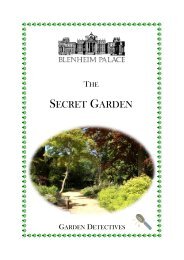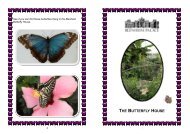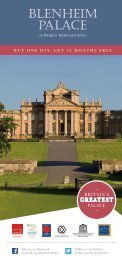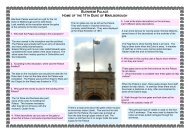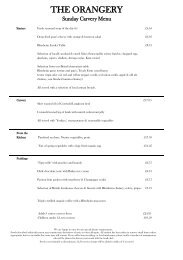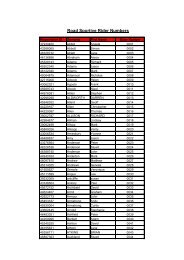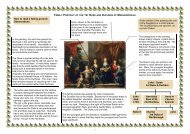You also want an ePaper? Increase the reach of your titles
YUMPU automatically turns print PDFs into web optimized ePapers that Google loves.
12<br />
Beech<br />
Ash<br />
Oak<br />
Sycamore<br />
Copper Beech<br />
Birch<br />
Poplar<br />
Willow<br />
Alder<br />
<strong>THE</strong> <strong>TREE</strong> <strong>TRAIL</strong>
2<br />
11<br />
The start of the trail<br />
PLEASE REMEMBER TO WATCH OUT FOR TRAFFIC WHEN WALKING<br />
ON ALL ROADS<br />
Stand outside the <strong>Palace</strong> gift shop on the grass underneath the large trees.<br />
Look carefully at the leaves on these trees.<br />
1] How many green leaf trees can you see in this area by the picnic tables?<br />
2] How many copper coloured leaf trees can you see?<br />
3] Compare the leaves you see with the pictures of leaves towards the end of<br />
this quiz. What kind of tree is this?<br />
Did you know?<br />
The trees growing outside the <strong>Palace</strong> gift shop can grow very tall, sometimes reaching<br />
40 metres in height. They are often used in Parks because they grow into large,<br />
rounded spreading trees.<br />
These trees are deciduous trees, this means they lose their leaves in winter. Deciduous<br />
trees have leaves in many shapes and sizes; they can be long and narrow like the<br />
leaves of a Weeping Willow, leaves can be triangular or heart shaped like the leaves<br />
of a Lime tree; some leaves have smooth edges, like the leaves of a Beech tree and<br />
some have jagged edged leaves like a leaf. The Horse Chestnut tree has a compound<br />
leaf of 5 segments coming off one stalk. Evergreen trees keep their leaves in<br />
winter. Some evergreens have broad leaves like the Holly tree but many evergreen<br />
conifers have needles instead of leaves.<br />
Find the following words in the word search:<br />
Cedar Beech Alder Weeping Willow<br />
Sycamore Cypress Oak Lime<br />
Elm Pine Yew Silver Birch<br />
Pine Walnut Rowan Apple<br />
Plane Hazel Ash Horse Chestnut Hornbeam<br />
Poplar<br />
P I N E O A K E S R O H<br />
C A C W A L N U T R H C<br />
E L Y L E L M C D O A H<br />
D D P I B E N I P W Z E<br />
A E R M Y E W E F A E S<br />
R R E E A P P L E N L T<br />
B R S W E E P I N G H N<br />
E A S W I L L O W G I U<br />
E L A S H R E V L I S T<br />
C P P L A N E H C R I B<br />
H O H O R N B E A M J L<br />
A P S Y C A M O R E K M<br />
Walk on until you get a clear view of the island. Look carefully at the trees on<br />
the small island in the Lake.<br />
Trees grow into many different shapes. There is the oval of the Poplar Tree;<br />
the triangle of the Fir tree and the Beech tree which has a rounded shape.<br />
4] There are a number of different shaped trees on this island in the lake;<br />
some rounded, pointed, tall and short. Put a circle around the tree pictures<br />
below whose shapes you can see on the Island.
10<br />
3<br />
The Answers<br />
1] Five<br />
2] One<br />
3] Beech trees<br />
6] The hole may have been caused by a branch falling off and by animals<br />
burrowing into the wood or by disease.<br />
7] Colours = reddish brown and dark green.<br />
9] Poplar trees are usually tall; have thin trunks, small grey green leaves.<br />
10] Oak, Beech, Willow.<br />
11] The oldest Oak tree is approx 150 years old.<br />
12] The beech trees have been protected with wire cages around their bases.<br />
13] The protection is to try and stop deer nibbling the young trees.<br />
15] The Horse Chestnut tree has a very large spread of branches and a thick<br />
trunk. The leaves have a candle like shape. Conkers.<br />
Lombardy Poplar<br />
Leylandii<br />
Larch<br />
Weeping Willow<br />
Ash<br />
This is a view of the Lake in winter. You can see the Beech trees in the background<br />
have lost their leaves. The large rounded blue Atlas Cedar trees, the Fir<br />
trees and the Cypress tree on the far side of the lake are still green.<br />
Beech<br />
Oak
4<br />
9<br />
5] Leaves come in all different shades of green and tree trunks come in all<br />
shades of brown and grey. What colours can you see on the island?<br />
Mark the colours you can see on the colour wheel below.<br />
1<br />
2<br />
Lime<br />
Plane<br />
Did you know?<br />
Some of the trees on the island are conifers. These trees can have the traditional<br />
Christmas tree shape. They have cones rather than flowers and needles instead of<br />
leaves and they do not lose their needles (i.e. leaves) in winter.<br />
3<br />
19] Stand beneath a Lime tree and look up at the branches and leaves. Then<br />
stand underneath a Plane tree and look up. Which tree lets through more<br />
light? Why do you think this is so? {Clue: look at both set of branches and see<br />
4<br />
how they have grown.}<br />
5<br />
Trees can often be recognised by the bark on their trunks. An Oak tree has<br />
rough bark as does the Horse Chestnut Tree. Some tree trunks are smooth<br />
like the Beech tree.<br />
6<br />
7<br />
20] How would you describe the bark on a Plane tree and how is it different<br />
from the bark on a Lime tree?<br />
8<br />
9<br />
Did you know?<br />
Some of the trees on the island are conifers. These trees can have the traditional<br />
Christmas tree shape. They have cones rather than flowers and pines instead of<br />
leaves and they do not lose their pines (i.e. leaves) in winter.<br />
Walk on towards the Grand Bridge. If you look towards the left side of the<br />
bridge there is a tree on the far side of the lake that has a large hole in its trunk.<br />
Beech Oak Lime Plane<br />
A tree’s trunk is very important. It gives the tree strength. A tree’s trunk will<br />
generally grow wider as the tree grows taller, so that the tree has more support<br />
as it grows. Nutrients are passed up the new wood of a tree. If a tree’s trunk is<br />
damaged or badly nibbled by rabbits or squirrels, the tree can die or grow<br />
more slowly than it was meant to.<br />
6] Suggest two reasons why this tree may have a hole in its trunk.<br />
Did you know?<br />
This tree is now a film star. It was used in one of the Harry Potter films.<br />
Poplar Birch Western Red Cedar Alder Sycamore
8<br />
5<br />
Continue to walk up towards the Woodstock entrance.<br />
As you walk see if you can spot any Sycamore trees. Their seeds are carried in<br />
pods which look like helicopter blades.<br />
As you walk away from the Woodstock entrance back towards<br />
the <strong>Palace</strong> you will pass a large Horse Chestnut on your left.<br />
These trees have compound leaves as shown in this picture.<br />
15] Describe the overall shape of this Horse Chestnut tree. Is<br />
it tall and thin or rounded and wide? What kind of flowers<br />
does this tree have in spring? Each autumn children collect<br />
the fruits of a Horse Chestnut tree and play with them. What is the name of<br />
this very well known fruit?<br />
Walk along the road until you reach the point where the wall of the park turns<br />
sharp left. Here there are two very large Cedar of Lebanon trees.<br />
The following list shows how you can decide if various trees are ancient or<br />
not. The list was made by the Woodland Trust.<br />
<br />
<br />
<br />
<br />
<br />
<br />
Oak – 3 adult hugs,<br />
Beech – 2 adult hugs,<br />
Scots Pine– 1 adult hug,<br />
Rowan – one adult hug,<br />
Birch – a wrist hug,<br />
Hawthorn – an elbow hug<br />
Cedar of Lebanon – 2 hugs<br />
16] Do you think these Cedar of Lebanon trees are ancient?<br />
17] Find part of the tree where a branch has been cut off. How else can you tell<br />
how old a tree is without hugging it?<br />
As you walk back to the <strong>Palace</strong> entrance you will turn into the avenue of trees.<br />
This avenue is planted with Lime and Plane trees.<br />
18] Use the pictures of leaves on the next page to decide which trees are Lime<br />
Trees and which are Plane.<br />
Continue across the Grand Bridge and look to your right. If it is dry, walk<br />
across the grass to reach the small grey stone<br />
plinth.<br />
This marks the spot where Woodstock Manor<br />
stood. It was knocked down when the <strong>Palace</strong> was<br />
built. Near the plinth is a young Wellingtonia.<br />
These trees grow to a great height and have a distinct<br />
shape, like a traditional Christmas tree.<br />
7] Make a sketch of this tree and list the colours<br />
you can see in the tree.<br />
A Wellingtonia<br />
A Wellingtonia<br />
These trees produce cones inside of which are<br />
the seeds. They have pine needles instead of<br />
leaves.<br />
8] Look carefully at the needles on this tree. Do<br />
they grow in any kind of pattern? Make a sketch<br />
in the box below.<br />
There is a picture of this kind of tree on the<br />
front of this leaflet.<br />
Return to the path and walk on to the tall Poplar<br />
trees.<br />
9] Look carefully at one of the Poplar trees. Write down three main features of<br />
the tree. These should be the kind of features that would help a person identify<br />
a Poplar tree. Do these Poplars look similar to the drawing of a Lombardy<br />
Poplar shown near question 4?<br />
Did you know?<br />
Poplar trees make very good wind breaks so they are often planted around fields where fruit<br />
trees are grown. The flowers are called catkins and come out in March and April.
6<br />
7<br />
Continue to walk along this path until you reach a cottage at the end of the<br />
lake. This is called Fisheries cottage.<br />
10] As you walk note down the names of<br />
three different kinds of tree you can see<br />
from the path.<br />
Near this cottage there are a number of<br />
oak trees.<br />
You can use the pictures in this booklet to<br />
make sure you are looking at Oak trees.<br />
Oak trees can live to a great age. The oldest tree in<br />
the Park is over 800 years old. The Oak trees here<br />
are not as old as that.<br />
11] Using the hints below, try and work out the age of<br />
the largest of these trees.<br />
You can use the hug method or a tape measure to get a pretty good idea of a<br />
tree's particular age from the girth of its trunk – (how wide it is).<br />
Trees will grow at different rates depending on how good soil, shelter or climate<br />
are and if they have space to grow freely or are hemmed in by<br />
neighbours. Trees grow faster when young and slow down in later life. Some<br />
species of tree are fast growing. (Christmas trees grow quickly).<br />
Generally broadleaved trees like Oak, Ash, Beech and Sycamore in UK<br />
woodlands put on about 1.5 to 2cm in circumference or girth per year. In<br />
open places like <strong>Blenheim</strong> Park the growth rate will be nearer 2.5cm annually.<br />
So by measuring the trunk circumference and dividing by 1.5, 2 or 2.5,<br />
you can make a guesstimate of age. If you don’t have a measuring tap with<br />
you then use the hug method. If an adult held out his/her arms to hug someone<br />
or to hug a tree the measurement would roughly be 1.5m (150 cm).<br />
DID YOU KNOW?<br />
Many, many years ago the whole of this part of Oxfordshire was covered by a forest.<br />
This was called Wychwood Forest. You can see some very old oak trees on the way<br />
down to the Pleasure Gardens. Oak trees produce very strong wood. Often oak<br />
was and is used for building and for ships. 129 oaks were felled in <strong>Blenheim</strong> Park to<br />
build ships for Nelson’s navy.<br />
Next take the right hand fork in the path and walk on towards Woodstock.<br />
The path rises above the cottage. The trees on your right as you walk are<br />
Beech trees.<br />
12] How have the Foresters protected these Beech trees?<br />
13] Why do you think these trees have been protected?<br />
Walk on until you reach the iron fencing<br />
under which water flows. Near here is an<br />
Alder tree.<br />
14] Look carefully at the leaves of the Alder<br />
tree and make a sketch of a leaf in the box<br />
below. What shape would you say the leaf<br />
was?<br />
Draw an alder leaf here.<br />
Did you know?<br />
Alder trees like to grow near water, which is why this tree is near the place where<br />
the River Glyme flows out of the Lake.<br />
Alder trees are a little bit dangerous. The wood that these trees produce is good<br />
for making gunpowder!



